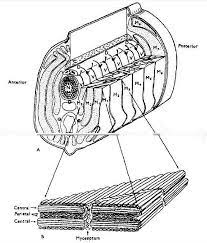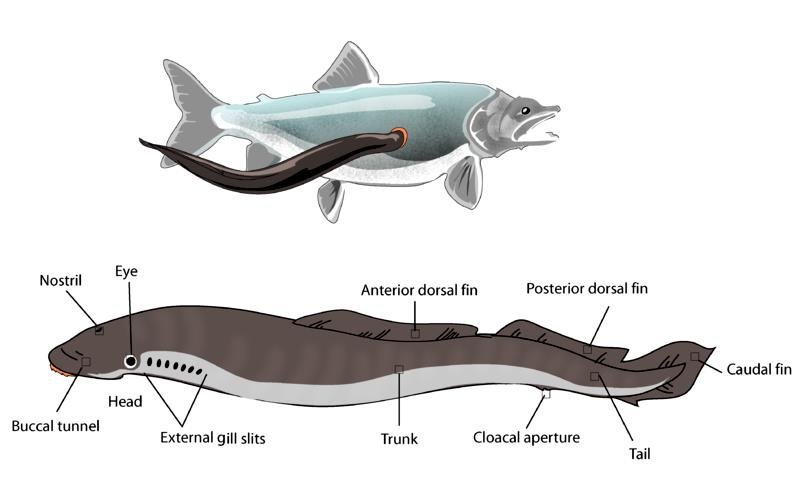Anatomy of Skin:
The skin has muti layered cells coverings, have dermis and epidermis layers, the skin is slimy or smooth due to the presence of mucous gland. The epidermis has different types of cells, the major type of cells present on the epidermis is mucous gland secret mucous, other glandular cells present on the epidermis secret different types of secretion, the club cells or kobenzelle have elongated cell body and hyaline cytoplasm.
The dermis layer has different components, collagen fibres, chromatophores cells and different types of pigment cells. The chromatophores are star-shaped cells present in between the dermis layer and the muscular layer, the chromatophores cells can migrate, the body colouration becomes dark or pale due to the migration of chromatophores cells.
The subcutaneous tissue present below the dermis has networks of blood vessels, fat tissue and different types of connective tissue.

Muscular System of Petromyzon:
The muscular system in Petromyzon show segmentation as that of Branchiostoma, the muscular system show ‘E’ shaped muscle segments or myotomes and each segment are separated from the other by myocommas. Myotomes are again divided into dorsal and ventral pairs through the horizontal septum.
The striated muscle present in myotomes helps them in locomotion, when the muscle contract on a side then the body bend towards this side, this process occurs on both sides alternatively which creates a propulsive force in the water.
The buccal cavity has a cup-shaped depression which helps them to attach to the body of large fish, the circular muscle present in the buccal cavity creates a sucking force to the cup-shaped buccal cavity depression. The mouth opening has a denticulated tongue the retractor and protractor muscle present in the tongue control the tongue movement.

Skeletal System of Petromyzon:
The skeletal system of Petromyzon do not have any bony components, the skeletal is considered to be the notochord and the cartilaginous fin rays. The notochord constitute the axial skeleton system, the notochord is made of gelatinous tissue and the rod-like elastic notochord give mechanical support.
The dorsal fin is supported by several cartilaginous rod-like fin rays, the fin rays are connected to the base and connected to the connective tissue covering of the notochord. Each fin rays are connected together which makes them strong enough which makes them able to navigate in the water.
The nerve cord has a rod-like endoskeletal structure on both sides of the nerve cord which are considered as neural arches of prevertebrae. The brain is protected by the cranium or brain box which gives protection to the brain and other sense organs. On the lateral side, they have seven pairs of small circular opening or gill slits, the gill present in the gill region are supported by an endoskeletal structure known as a branchial bucket.
The tongue is also internally supported by an endoskeletal structure known as lingual cartilage which makes the tongue stiff. The buccal cavity has a cup-shaped depression, at the centre of the buccal cavity have a central circular mouth opening, the buccal funnel is supported by a circular endoskeletal structure, annular cartilage supports the buccal cavity region.

Some internal organs are also supported by the endoskeletal structure, for example, the heart has a special type of endoskeletal support. The heart has a covering of pericardium which protects the heart from external mechanical injuries and in addition, the heart has an endoskeletal structure made of cartilaginous tissues which makes the heart more strong.
Detailed Study On
External Morphology of Petromyzon
Habit and Habitat of Petromyzon(Lamprey)
Classification of Class Ostracodermi
Phylogeny of Subphylum Vertebrata
An Overview of Classification in Subphylum Vertebrata
Subphylum Vertebrata and its Diversity
Cephalochordata Characteristics Features Classification Examples and Diagram
Urochordata Classification Morphology Characteristic Features
Characteristics Features of Hemichordata
General Comparison of Hemichordata Urochordata and Cephalochordata
Comparative Study of Digestive System in Hemichordata Cephaochordata and Urochordata
Hi Everyone!!! Welcome to Imaluop. Imaluop always try to learn some new and he want to share to other people. Here we will try to learn various topics on Science, specially on Biological Sciences.